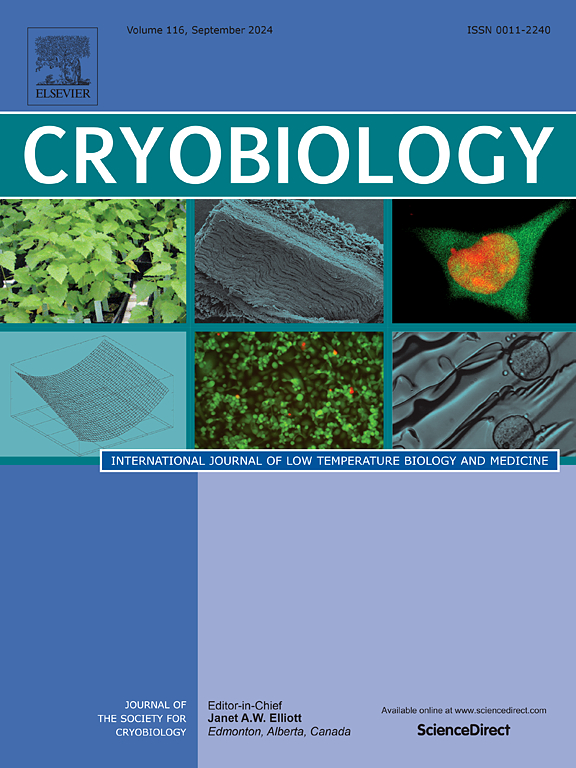装载姜黄素的乳质体纳米载体是一种很有前途的方法,可以改善解冻后种马精子的质量特征、凋亡基因表达和流式细胞术评估。
IF 2.1
3区 生物学
Q2 BIOLOGY
引用次数: 0
摘要
低温保存培养基的优化是减少解冻后精子氧化损伤的关键。本研究旨在评估姜黄素负载的niosomal nanoc载体(CurLNN)的抗氧化性能,包括功能特征、凋亡基因的相对表达,以及流式细胞术评估融化后种马精子的凋亡样变化、活性氧产生(ROS)、线粒体膜电位和染色质完整性。在INRA96冷冻培养基中加入20 μM姜黄素(Cur)或CurLNN,稀释25份射精后冷冻保存。结果表明,用Cur,特别是CurLNN处理的精子,表现出更高的总运动和进行性运动百分比,以及VAP、VSL和STR运动学。质膜功能增强,精子异常减少(P < 0.05)。低温稀释液中加入Cur和CurLNN后,细胞活力增加(P < 0.05), MDA水平降低。流式细胞术分析显示,Cur和CurLNN处理显著提高了种马解冻后精子的线粒体电位活性,降低了ROS的产生(P < 0.05),增加了活精子的比例(P < 0.05),降低了后期凋亡的比例(P < 0.05)。此外,在冷冻稀释剂中添加cur和CurLNN可显著提高Bcl2抗凋亡基因的相对表达量(P < 0.05),而在冷冻稀释剂中添加CurLNN可显著降低马解冻后精子中Bax促凋亡基因的相对表达量(P < 0.05)。综上所述,本研究结果表明,CurLNN具有增强的抗氧化特性,通过减轻低温保存过程中的氧化应激,有助于提高精子的功能质量。本文章由计算机程序翻译,如有差异,请以英文原文为准。
Curcumin–loaded niosomal nanocarriers offer a promising approach to improve quality characteristics, apoptotic gene expression, and flow cytometry assessments of stallion spermatozoa after thawing
The optimization of cryopreservation media to reduce oxidative damage on post-thaw spermatozoa is crucial. This research aimed to assess the antioxidant properties of curcumin-loaded niosomal nanocarriers (CurLNN) on the functional characteristics, the relative expression of apoptotic genes, and flow cytometry assessments of apoptotic-like changes, reactive oxygen species production (ROS), mitochondrial membrane potential, and chromatin integrity in stallion spermatozoa following thawing. Twenty-five ejaculates were diluted in INRA96 freezing media supplemented with 20 μM of either curcumin (Cur) or CurLNN and then cryopreserved. Results demonstrated that spermatozoa treated with Cur, particularly CurLNN, exhibited higher percentages of total and progressive motility, as well as VAP, VSL, and STR kinematics. Additionally, the functionality of the plasma membrane was enhanced, and there was a decrease in spermatozoa abnormality (P < 0.05). The incorporation of cryo-diluent medium with Cur and CurLNN led to increased viability (P < 0.05), while simultaneously reducing the levels of MDA. Flow cytometry analysis revealed a significant enhancement in mitochondrial potential activity, a reduction (P < 0.05) in ROS production, and an increase (P < 0.05) in the proportion of live and a decrease in late apoptotic stallion post-thawed spermatozoa treated with both Cur and CurLNN. Moreover, the relative expression of the Bcl2 anti-apoptotic gene increased (P < 0.05) by the addition of cur and CurLNN in cryo-diluent extender, while inclusion of CurLNN in cryo-diluent medium resulted in a significant reduction (P < 0.05) in the relative expression of the Bax pro-apoptotic gene in stallion post-thawed spermatozoa. In summary, the findings of this study demonstrated that CurLNN exhibits enhanced antioxidant properties, which contribute to the improved functional quality of spermatozoa by alleviating oxidative stress during the cryopreservation process.
求助全文
通过发布文献求助,成功后即可免费获取论文全文。
去求助
来源期刊

Cryobiology
生物-生理学
CiteScore
5.40
自引率
7.40%
发文量
71
审稿时长
56 days
期刊介绍:
Cryobiology: International Journal of Low Temperature Biology and Medicine publishes research articles on all aspects of low temperature biology and medicine.
Research Areas include:
• Cryoprotective additives and their pharmacological actions
• Cryosurgery
• Freeze-drying
• Freezing
• Frost hardiness in plants
• Hibernation
• Hypothermia
• Medical applications of reduced temperature
• Perfusion of organs
• All pertinent methodologies
Cryobiology is the official journal of the Society for Cryobiology.
 求助内容:
求助内容: 应助结果提醒方式:
应助结果提醒方式:


